

Crafting in Guild Wars 2 is something of a mixed bag; on the one hand, you’ve got simple, uninspired disciplines designed to give you access to a variety of mostly useless weapons, armours and accessories that you’ll need to craft in order to raise your skill from 1 to 400 to access [Crafted Exotics]; and on the other, you’ve got a near limitless amount of variety in crafting options beyond that point, accessible via the Mystic Forge, with no one clear goal, and seemingly thousands of possible combinations.
Though in many ways this system resembles those found in a traditional themepark MMORPG, there are almost as many ways in which it veers off the path completely, leaving you both excited and confused at almost every turn. If it didn’t require grinding materials for what’s beginning to look like a hundred years, we’d be right behind it. But as it stands, our feelings for this system are caught somewhere between falling hopelessly in love, and falling dangerously from the nearest cliff.

Opinions aside, crafting in Guild Wars 2 is expansive, to say the least, and we’ve been working hard since launch to locate every morsel of information we can find. A lot of it has become redundant with the recent slaughter of changes Arenanet have made in the past weeks (anyone else start experimenting with Cooking during the first week?); though, rest assured, this guide will remain as up-to-date as we can make it, for as long as we’re actively playing GW2.
Beginning to craft in Guild Wars 2 is relatively simple; first, you’ll need to begin gathering the materials you’ll need to advance, and you can do, for the most part, by simply progressing through the game.
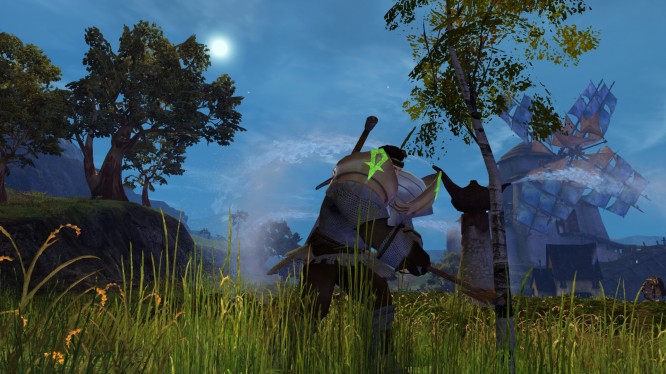
There are two core types of gathering materials that you’ll need:
Common Materials refer to materials that can be gathered by locating the appropriate gathering node and equipping the appropriate gathering tool, or by salvaging items. There are 3 types of nodes:
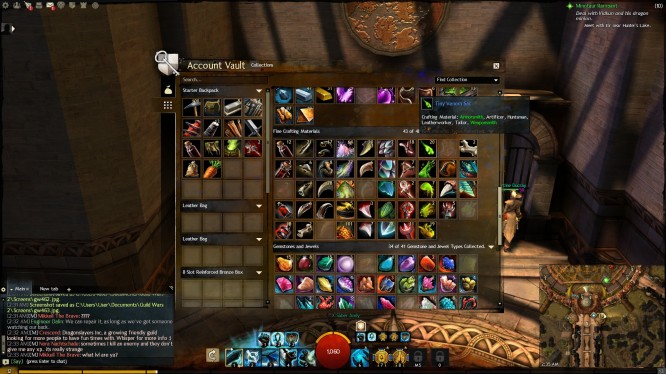
Unlike Common Materials, Fine Materials cannot be obtained from a node and are obtained by looting dead monsters, or hidden within bags dropped by dead monsters.
Both Common and Fine Materials are categorised into 6 tiers, with Tier 1 items available from level and considered easy to obtain, and Tier 6 being available from level 70 onward, and are considerably more difficult to obtain.
Disciplines, also (incorrectly) referred to as Professions, are used to determine which type of items are created using the gathering materials list above. There are 8 Crafting Disciplines in Guild Wars 2:
With the exclusion of Cooking, which requires the collection and combination of a significantly more diverse field of ingredients, all disciplines follow a very similar progression path.
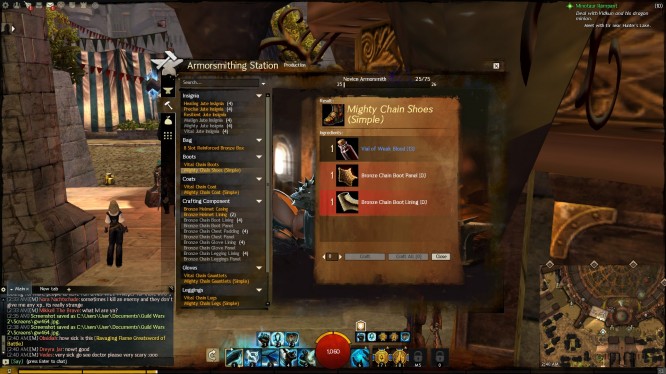
Simply put, in order to increase a discipline from level 1 to 400, you’ll need to craft multiple items from your current ‘tier’ in order to unlock the tier that follows. So, beginning with copper, you’ll need to advance to level 75 by crafting various pieces of equipment before you can begin crafting with Iron, and so on.
This can mostly be achieved by simply using common gathering materials to create items that are used in the creation of equipment; however, as you near the next tier, you’ll find it increasingly difficult to advance without the use of discovery.

Discovery is the process of learning new recipes to craft by combining items. In essence, this works around using insignias and inscriptions to combine various mundane weapon and armor components to create usable equipment. Not only does this produce a piece of equipment with statistics predetermined by you, but it also gives a large bonus to crafting experience making it an essential part of leveling your discipline. Runes and Sigils can also be crafted in this manner, and alongside providing a great boost you your crafting level, can also be used to upgrade your equipment outside of the crafting system.
In order to increase Weaponsmithing from level 1 to 75, players would first need to refine [Green Wood Logs] and [Copper Ore] into [Green Wood Planks], [Green Wood Dowels] and [Bronze Ingots].
The [Bronze Ingots] can then be used to create, say, a [Bronze Dagger Blade] and [Bronze Dagger Hilt], which are 2 of the 3 items required to create a [X Bronze Dagger].
The [Green Wood Plank] can then be used to make the [Green Wood Dowel], which can then be used, in combination with a selection of [Fine Crafting Materials], such as [Bone Chips], to create an [Inscription]. The type of inscription created is determined by the type of Fine Material used, and is indicated by the recipe.
Now, they can use the Discovery Menu to add the [Inscription], [Bronze Dagger Blade] and [Bronze Dagger Hilt] to create an [X Bronze Dagger], with the X representing the type of inscription used.
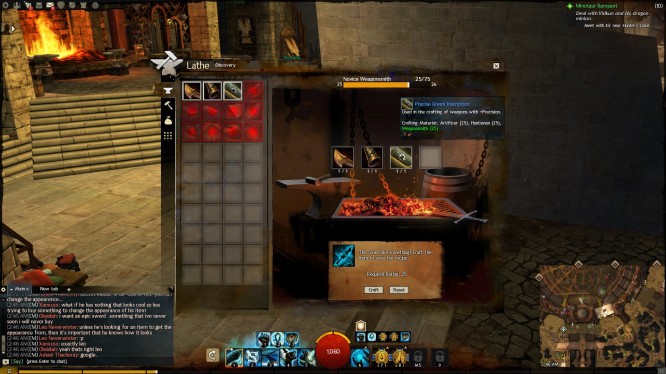
This process is mostly the same through all tiers of crafting, with each tier containing 2 sets – the first a simple version requiring a small amount of materials, and the second an advanced set requiring significantly more – until level 400 is achieved, allowing the use of Tier 6 materials such as [Ancient Wood] and [Orichalcum Ore] to create [Crafted Exotics].
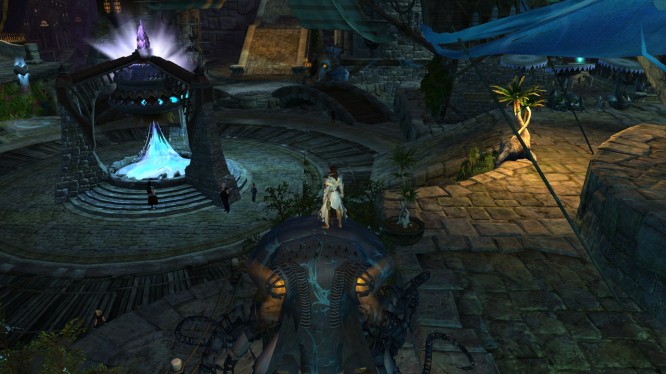
The Mystic Forge, considered to be a core component of ‘endgame crafting’ in Guild Wars 2, is a large fountain located in the centre of Lion’s Arch, The Heart of the Mists and throughout the World vs World areas.
In the simplest possible sense, it works by throwing 4 items into the forge to receive 1 item back, generally of greater value. This can be achieved by using either random recipes – which is, quite literally, the process of throwing in random items – or non-random recipes, which will always return a specific item as indicated in the recipe.
The Mystic Forge can be used for crafting everything from simple equipment improvements (for example, by throwing in 4 masterwork (green) quality items for the chance to get a rare (yellow) piece of equipment back), all the way to crafting [Legendary Weapons], and everything in between.
It’s a long, often arduous journey, that yields just as much disappointment as it does joy; though, by unlocking its secrets, paves the way to some of the most powerful items in the game. It’s also gambling, and as with all forms of gambling, never throw something into the pot that you can’t afford to lose.
Mystic Coins are provided as rewards from daily and monthly achievements. Completing all of your daily achievements awards one coin, whereas monthly awards twenty. These coins are not bound to you in any way, so buying and selling on the trading post when required is common.

Many non-random forge recipes will require a number of Mystic Coins, so it can be worth holding onto them if you intend to use the forge.
The Mystic Chest is a new forge recipe designed to help even out the market whenever there is an excess of a particular item. While the items used for the recipe may change depending on what items are currently supplied in excess, the result will usually be the same.
In this example, we’ll use Sticks of Butter, which were available on the market in such numbers that no amount of people could ever hope to use them all. Other items can be used in place of the Sticks of Butter, if they qualify for the recipe.
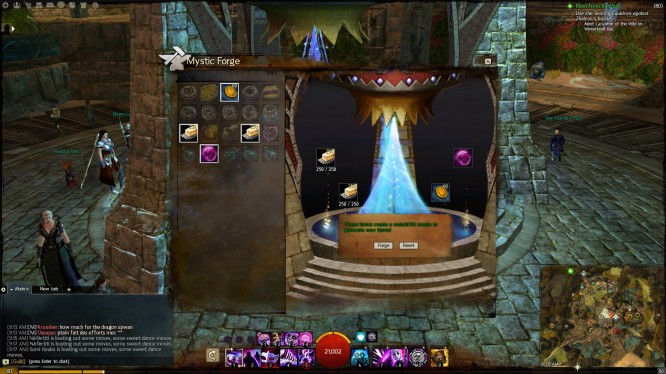
To create the chest, combine 500 Sticks of Butter (2 stacks), a Mystic Coin and a Glob of Ectoplasm. The contents of the chest will usually be a crystal worth between 10-30 silver to vendor and additional forge items or novelty potions.
Mystic Weapons are equivalent to any endgame exotic weapon statistically, but provide a (possibly) cheaper way to obtain more exotic weapons to use while trying to get your legendary precursor weapon.
Combining 5 of each of the normal weapon components, 30-50 mystic coins and an Eldritch Scroll in the forge will result in the mystic version of the weapon.
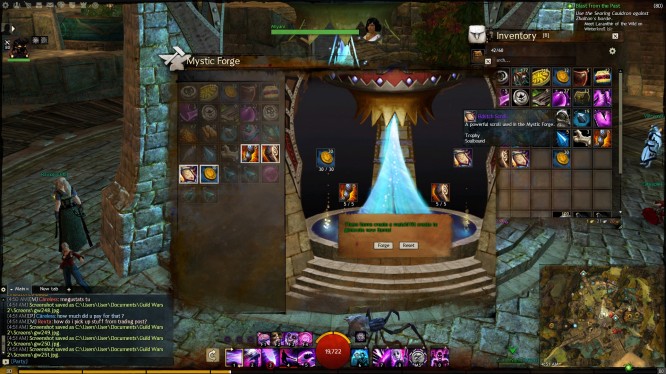
The mystic weapons appear visually identical to the Crucible of Eternity set of weapons, colored blue instead of red. While you can’t control what set of statistics the weapon will have, it can be sold on the trading post or used in a random reforging like any other exotic.
While the mystic weapons bypass many of the rarer crafting materials normally needed, bear in mind that an Eldritch Scroll will cost you 50 skill points.
Material transmutations allow you to take an excess of lower tiered common or fine materials and upgrade them to the next tier. For instance, a stack of copper ore (1st tier) can be transmuted into 10-50 iron ore (2nd tier).
In order to upgrade any common material, place a full stack (250) of the material you want to upgrade into the forge along with a single piece of the material you want to change it into, as well as 5 piles of dust and a number of Philosopher’s Stones.
The tier of dust required is equal to the item you’re creating. So in the case of Copper Ore to Iron Ore you would require 5 Piles of Shimmering Dust.
The number of Philosopher’s Stones required is based on the tier of the stack of items you’re changing. In the copper to iron example, Copper is tier 1, so only one Philosopher’s Stone would be required.
So a full Mithril Ore to Orichalcum Ore transmutation would look like this:
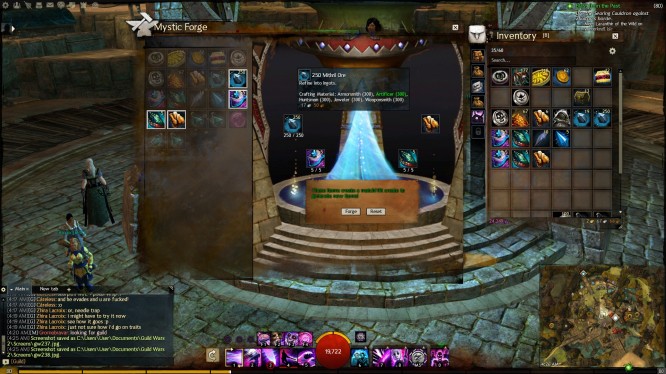
Recipes can be gained from the forge which will allow you to cook trays and feasts and place them in the world for anyone nearby to gain free buffs.
While not all foods can be combined into trays and feasts in this manner, the ones that can need to be combined with Mystic Coins, Elonian Wine and Crystals to generate the recipe. The higher the level of food, the greater the number of components required.
Siege weapons for WvW can be upgraded at the mystic forge by combining a number of blueprints of the weapon you want to upgrade, some mithril ore and elder wood logs (both common tier 5) and a siege manual. The amount of blueprints, mithril, wood and siege manuals required will vary depending on what you’re upgrading.
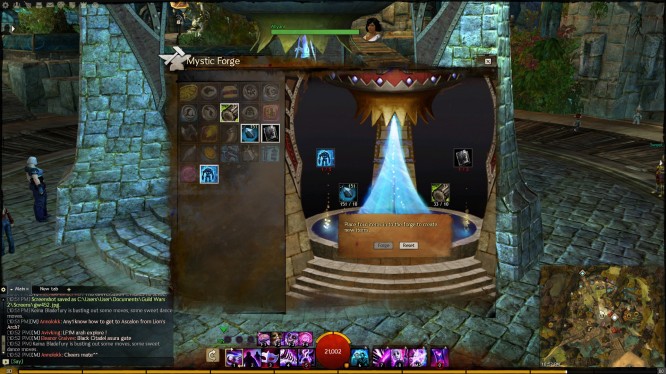
The result will be an upgraded siege weapon of the same type. It will be more powerful than the standard weapons, but also require more supplies to build.
Armor Boxes and Satchels are packages that contain an entire set of crafted armor. In order to obtain the recipe to create any given set, combine a number of crystals, elonian wine and mystic coins along with the chest piece of the set you wish to obtain in the mystic forge.
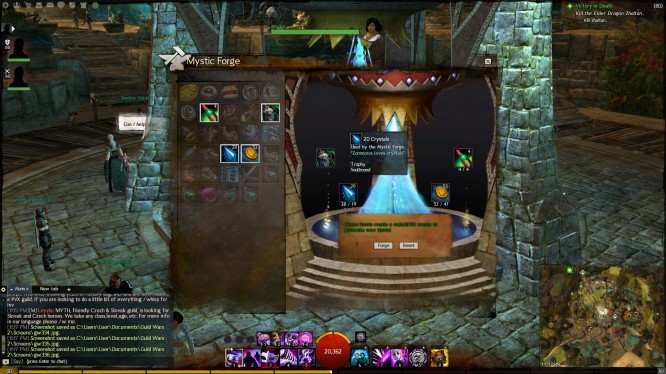
The result will be a recipe for the appropriate crafting discipline of the set you chose. Currently, the boxes/satchels seem to require more materials than would be necessary if each piece was crafted individually, so unless this is changed in the future these recipes are not worth the cost of obtaining.
PvP crafting allows you to break down PvP gear obtained as rewards via sPvP and reforge the components into new gear. PvP specific equipment can be salvaged through the use of a PvP Salvage Kit which costs 100 glory from the PvP rewards vendors.

The random materials gained from salvage can be combined with a token to create a new piece of PvP gear. There are numerous tokens available and each one will help you guide the resulting piece towards what you want. For instance, using a Light Coat Token in the combination will always result in a light chest piece.
Different tiers exist for the sPvP equipment as well. Tier 2 equipment is gained at Deer rank (rank 10) and so on – with the resulting salvage materials being of the same tier as the item salvaged.
Legendary weapons are the ultimate undertaking in Guild Wars 2, requiring huge amounts of time, skill, luck and coin in order to obtain. While they’re not statistically better than crafted exotic gear, each legendary has a unique design certain to impress onlookers.
There are currently 21 known Legendary Weapons – one for each type of weapon, with the exclusion of the Greatsword, which has 3. Generally, with few exceptions, obtaining a legendary weapon requires 4 key components: a base weapon that can be obtained by depositing 4 exotic weapons of that type into the Mystic Forge (which, it should be mentioned, only offers a chance of returning the required weapon), and 3 gifts; the first 2 will always be a Gift of Fortune and a Gift of Mastery, which are, by comparison, easy to obtain, and a 3rd gift unique to the weapon you’re trying to craft, which is incredibly difficult to obtain.
Gifts, known as non-random recipes, are created using the Mystic Forge by first purchasing the recipe for 10g from Miyani, and NPC vendor near the Mystic Forge. Some gifts are also obtained from the specific dungeon vendors, and others can only be obtained through discipline crafting. Combined, they make up the major requirements for crafting legendary weapons; however, the components required to craft the gift after purchasing the recipe are extremely varied.
A player is looking to craft [The Bifrost], the Legendary Staff Weapon. This requires [The Legend], a chance item obtained by depositing 4 exotic staves into the Mystic Forge.
Next, the player requires the [Gift of Fortune]. This can be crafted by depositing [77 Mystic Clovers], [250 Globs of Ectoplasm], [1 Gift of Magic] and [1 Gift of Might] into the Mystic Forge. To obtain these items, the player must collect:
Now, the player has 2 of the 4 items required to make [Bifrost]. Next, they need to craft a [Gift of Mastery], which requires [1 Bloodstone Shard], [250 Obsidian Shards], [1 Gift of Exploration] and [1 Gift of Battle]. They require:

With that created, only 1 item remains: the [Gift of the Bifrost], the unique gift required to create this specific legendary weapon. It requires [1 Gift of Color], [1 Gift of Energy], [100 Icy Runestones] and [1 Superior Sigil of Nullification]. They can be obtained by:
And that’s it. With these 4 items acquired, they can be deposited into the Mystic Forge to receive [Bifrost]. As you can see, this is a notoriously difficult process, and that’s just for 1 legendary weapon. Some are even more difficult; in particular, the greatsword [Eternity], which requires both [Sunrise] and [Twilight], both legendary greatswords on their own, as 2 of the 4 components required for creation. The remaining 2 materials are currently unknown.
We can’t list the process for crafting ever legendary weapon here today, after all, we’ve got our own legendaries to craft; however, you can find a list of all required ingredients on the official Guild Wars 2 Wiki by following the link above.
Additionally, take a look at the Legendary Guide on GW2DB for further information regarding the crafting of specific weapons. Much love to the guys working on this guide.
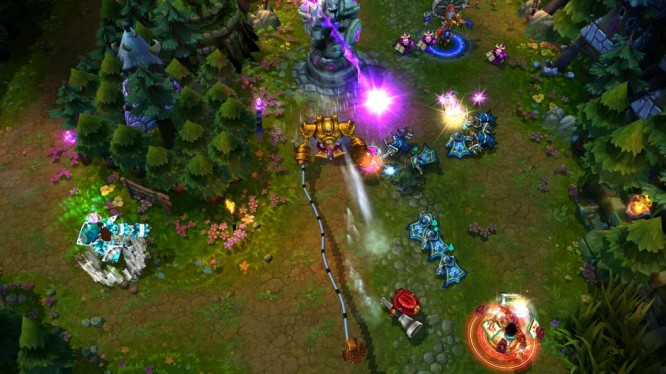


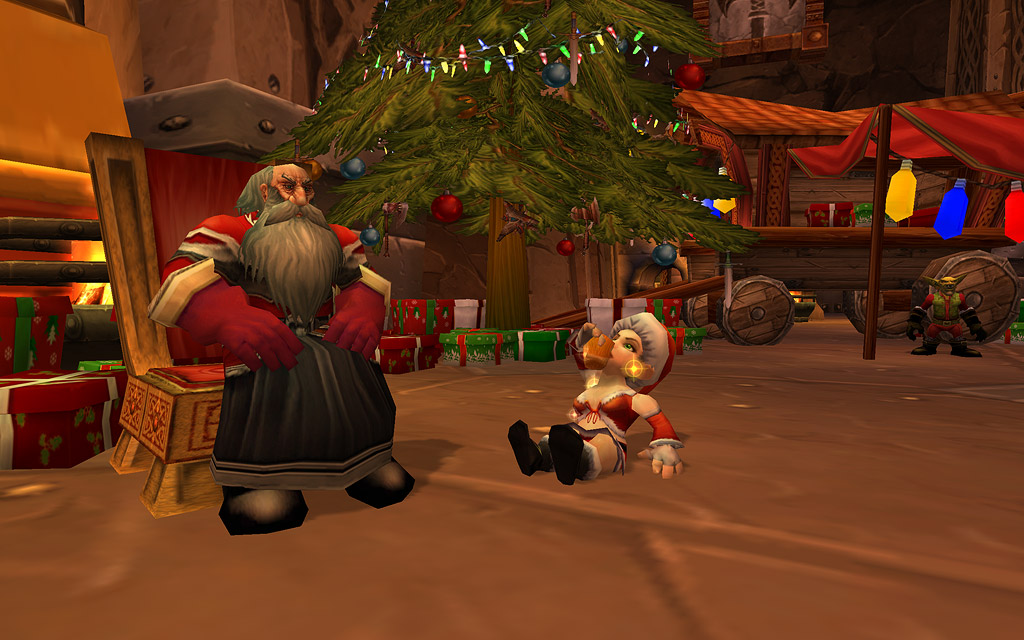
 Trove: Guide to Ranged Classes
Trove: Guide to Ranged Classes Movies That Would Make Great MMOs .
Movies That Would Make Great MMOs . DotA 2: How to stack the Radiant's neutral creep camps
DotA 2: How to stack the Radiant's neutral creep camps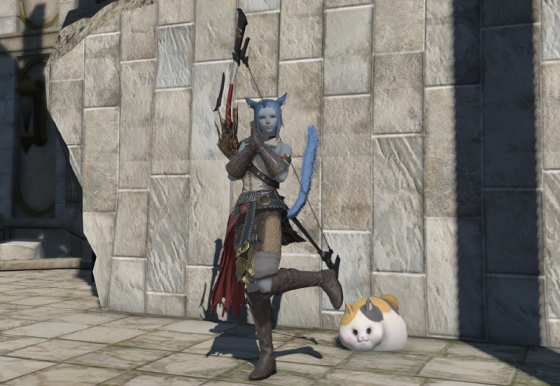 Eorzean Evening Post: Gearing Up in Patch 3.1 .
Eorzean Evening Post: Gearing Up in Patch 3.1 . The WarZ: A Quest for Cash .
The WarZ: A Quest for Cash .